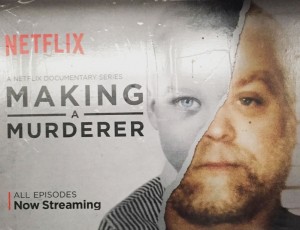
By Jessica Cunha ’17
Imagine being sent to prison for a crime you didn’t commit. It may seem like a nightmare, but in “Making a Murderer,” the case around Wisconsin man Steven Avery’s multiple arrests raises questions over whether this is just an irrational fear.
“Making a Murderer” is a Netflix 10-part documentary series released on Dec. 18, which follows the incredible story of Avery, who was arrested and convicted of sexually assaulting Penny Beerntsen, despite having an alibi. After serving 18 years in prison, he was exonerated in 2003 due to DNA evidence, only to then later be accused and convicted of murdering Teresa Halbach, who had recently started her own photography business.
The series focuses on the Manitowoc County sheriff’s department and their handling of Avery’s case, which revealed a serious conflict of interest with the county officials who participated in Halbach’s investigation.
This blatant disregard for finding the truth is not as uncommon as one may think. HBO’s miniseries, “The Jinx,” which released its first episode on February 8, 2015, delves into the opposite end of the spectrum, focusing on an accused murderer who escaped conviction, Robert Durst. It breaks down the murders that he was tied to, including interviews, reenactments, police evidence and footage. The program gained even more traction right before the series finale, when Durst was arrested on first degree murder charges. In the final moments of the episode, he incriminates himself when he thinks his microphone is off. “What the hell did I do? Killed them all, of course,” said Durst.
These two cases reveal that, without going through the proper channels, the guilty could be sent free, while the innocent stay behind bars.
Celebrities have also taken a strong stance on the documentary, especially on Twitter. On Jan. 17, model Gigi Hadid said, “Corruption in that law enforcement community is so obvious to me. They will clearly do anything to silence someone.”
Actor Paul Wesley agreed full- heartedly with Hadid on Twitter. “I’ve just spent 10 hours watching ‘Making of a Murderer’ on Netflix,” Wesley said. “What an astounding and terrifying look at our judicial system.”
“Making a Murderer” has become one of the most talked about shows in not just the entertainment industry, but with the general public. Unlike other crime dramas, such as “Law and Order,” it is one hundred percent grounded in reality. The injustices displayed within the documentary have that much more of an impact because it isn’t fiction.
Junior Nicole Mellilo thinks that the reason these crime shows are so interesting is because they break down the crime and the people involved. “I love the psychological part of them,” Mellilo said. “Being able to see their mindset is entertaining.”
However, not everyone agrees with the perspective presented by the documentary. Critics of the Netflix series argue that there were crucial facts of the case left out. The New York Times reported on Jan. 5 that Ken Kratz, the prosecutor in the case, called the story “nonsense” because the film portrayed a very one sided argument. “The series really presents misinformation,” Kratz said.
Junior Hailey Blum said she feels it is unrealistic to expect the law to be accurate all the time. “For the most part, I would say the justice system is objective because it has to follow cold hard facts before making a verdict,” Blum said. “But, nothing is ever perfect.”
One of the most conflicting witnesses in Avery’s case is his ex-fiancee, Jodi Stachowski. In the documentary, she advocates for him, defending his innocence. Then in January, she was interviewed by Nancy Grace, and Stachowski revealed that she believes he is guilty. “He told me once [that all women] owe him because of the one [woman] who sent him to prison the first time,” said Stachowski.
The nature of the case raises serious questions over the reliability of the justice system and those who work under the institution itself.



